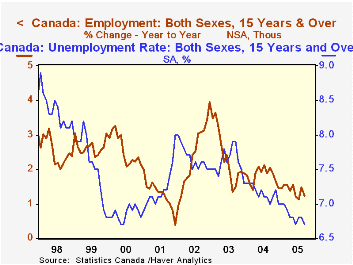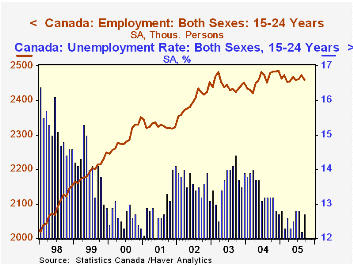 Global| Oct 07 2005
Global| Oct 07 2005Canadian Jobs Slip in September; Declining Participation Holds Down Unemployment
Summary
Both jobs and unemployment edged down in Canada in September. The number of jobs eased by 2,300 while the unemployment rate ticked down to 6.7% from 6.8% in August. A gradual but persistent decline in labor force participation is what [...]

Both jobs and unemployment edged down in Canada in September. The number of jobs eased by 2,300 while the unemployment rate ticked down to 6.7% from 6.8% in August. A gradual but persistent decline in labor force participation is what produces these seemingly contradictory movements in employment and unemployment.
The jobs decrease was actually quite minor on the month. An outsized drop in finance, 29,000, actually looks a bit peculiar for that sector; other jobs decreases occurred in manufacturing, business services, wholesale and retail trade, accommodation and food services and public administration. But these job losses were almost entirely offset by a 20,000 gain in information industries, plus increases in "other" services, professional and technical services, education and health care. Employment had gained 27,500 in August, but overall, the trend in jobs growth has been slowing.
The unemployment rate returned to 6.7% after two months at 6.8%. The 6.7% level is the lowest since the same in May and June of 2000, and hadn't been undercut before that for just over 25 years. However, as we have explained a couple of times earlier this year in discussing the Canadian labor data, this low rate doesn't suggest that these labor markets are tight. The labor force also decreased marginally in September and continues to exhibit a 12-month growth rate at or below 1%. The labor force participation rate fell again. Its current 67.1% is the lowest since August 2002; it reflects a slight decrease in participation above age 25 and a bigger decline in younger people's participation. The unemployment rate for young workers is hovering around 12.5%, having come down from well over 14% just two years ago. But it is reduced participation of this age group that has helped its recent unemployment picture. Employment opportunities for them have been almost completely flat for about three years.
| CanadaAge 15 and over | Mo/Mo Change, 000sYr/Yr % Sept | December/December|||||
|---|---|---|---|---|---|---|
| Sept 2005 | Aug 2005 | 2004 | 2003 | 2002 | ||
| Employment | -2.3 | 27.5 | 1.2% | 1.5% | 1.9% | 4.0% |
| Goods- Producing | -14.5 | 24.6 | 0.4% | 2.0% | -0.5% | 6.3% |
| Service- Producing | 12.2 | 2.8 | 1.5% | 1.2% | 2.6% | 3.1% |
| Labor Force | -7.4 | -30.8 | 0.7% | 1.1% | 1.6% | 3.2% |
| Unemployment Rate | Sept 2005 | Aug 2005 | Sept 2004 | Annual Average | ||
| 6.8% | 7.0% | 7.3% | 7.2% | 7.7% | 7.7% | |
| Participation Rate | 77.8% | 78.0% | 78.3% | 78.2% | 78.1% | 77.4% |
Carol Stone, CBE
AuthorMore in Author Profile »Carol Stone, CBE came to Haver Analytics in 2003 following more than 35 years as a financial market economist at major Wall Street financial institutions, most especially Merrill Lynch and Nomura Securities. She had broad experience in analysis and forecasting of flow-of-funds accounts, the federal budget and Federal Reserve operations. At Nomura Securities, among other duties, she developed various indicator forecasting tools and edited a daily global publication produced in London and New York for readers in Tokyo. At Haver Analytics, Carol was a member of the Research Department, aiding database managers with research and documentation efforts, as well as posting commentary on select economic reports. In addition, she conducted Ways-of-the-World, a blog on economic issues for an Episcopal-Church-affiliated website, The Geranium Farm. During her career, Carol served as an officer of the Money Marketeers and the Downtown Economists Club. She had a PhD from NYU's Stern School of Business. She lived in Brooklyn, New York, and had a weekend home on Long Island.





